Abstract
1 Pargyline treatment, 1 h before (+)-amphetamine (1 mg/kg), reduced amphetamine-stimulated motor activity. This inhibition was reversed in animals pretreated with p-chlorophenylalanine (PCPA).
2 Following treatment with PCPA or 5,6-dihydroxytryptamine (5,6-DHT), amphetamine-induced locomotor activity was significantly potentiated. The increased response to amphetamine in PCPA-treated rats was reversed in animals pretreated with 5-hydroxytryptophan.
3 The inhibition of amphetamine-stimulated locomotor activity by treatment with 6-hydroxydopamine was not reversed by PCPA treatment.
4 Stereotypies produced by amphetamine were not found to be altered by depletion of 5-hydroxytryptamine.
5 Induction of adrenal tyrosine hydroxylase activity produced by chronic amphetamine administration was significantly potentiated by PCPA, emphasizing the involvement of a 5-hydroxytryptamine inhibitory system in more than one action of amphetamine.
Full text
PDF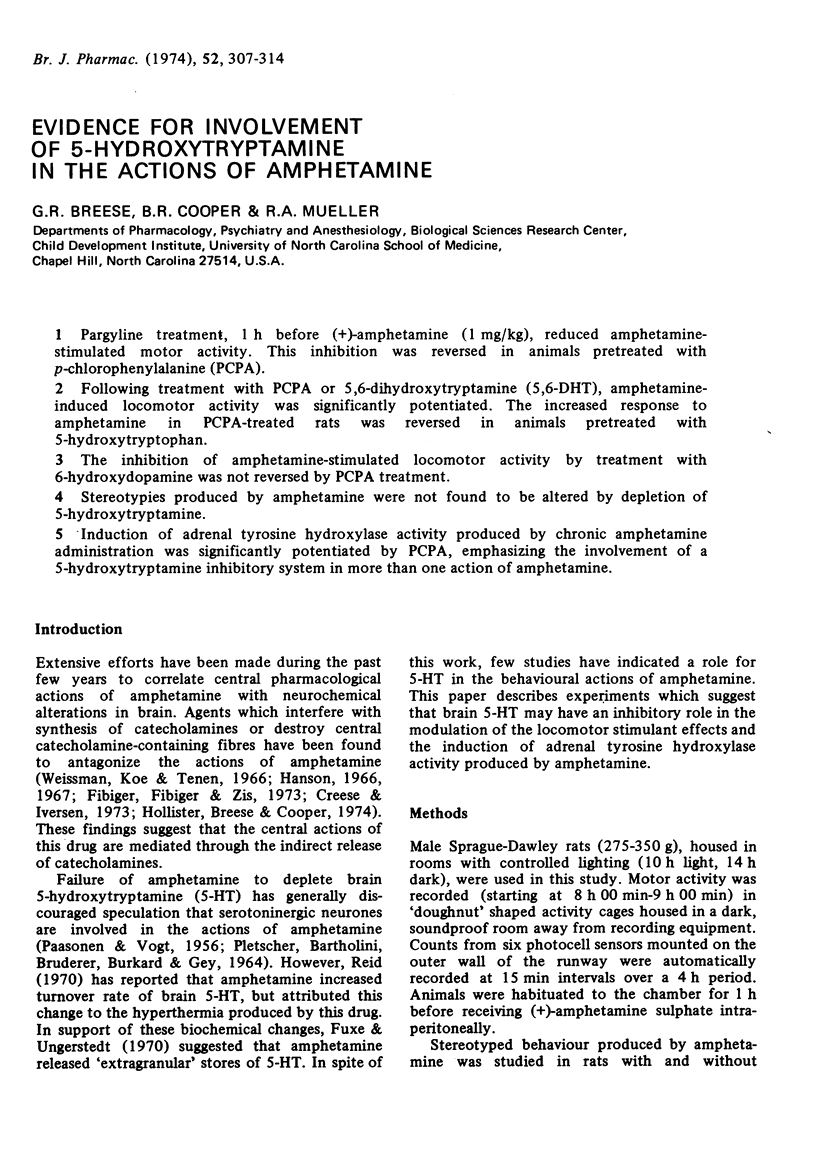
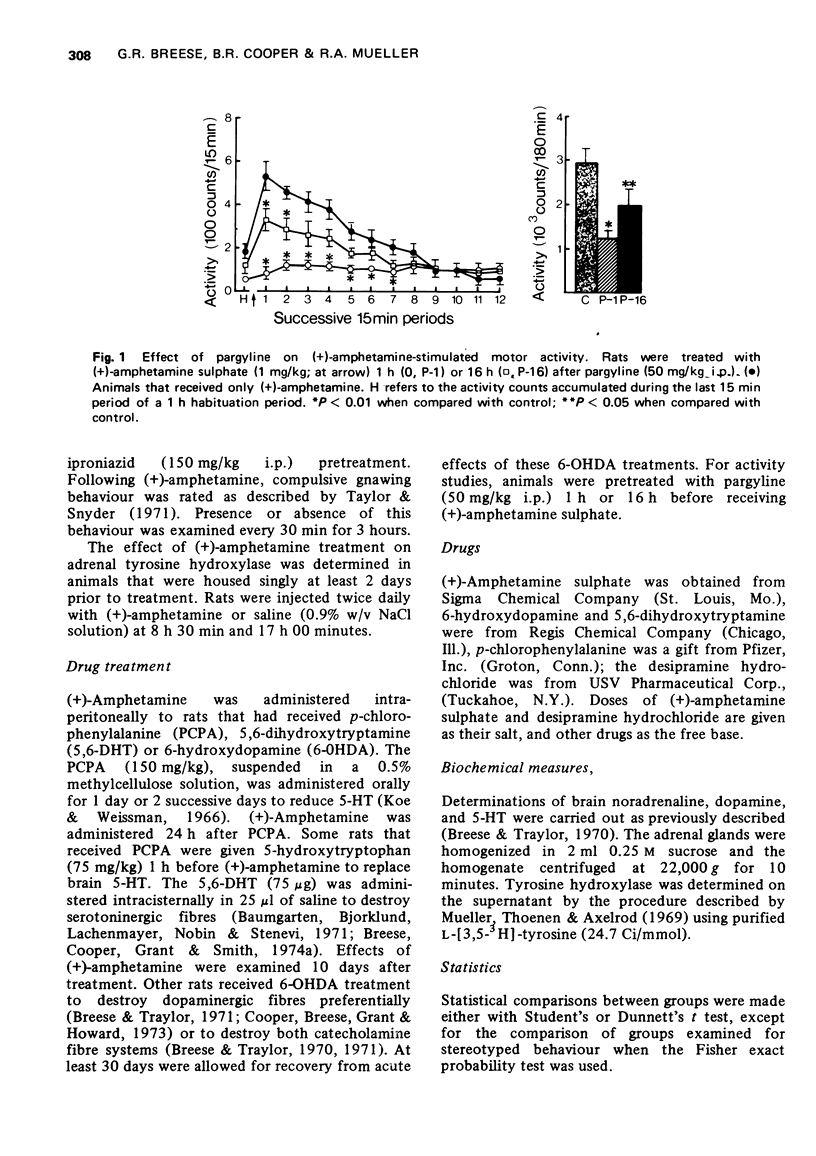
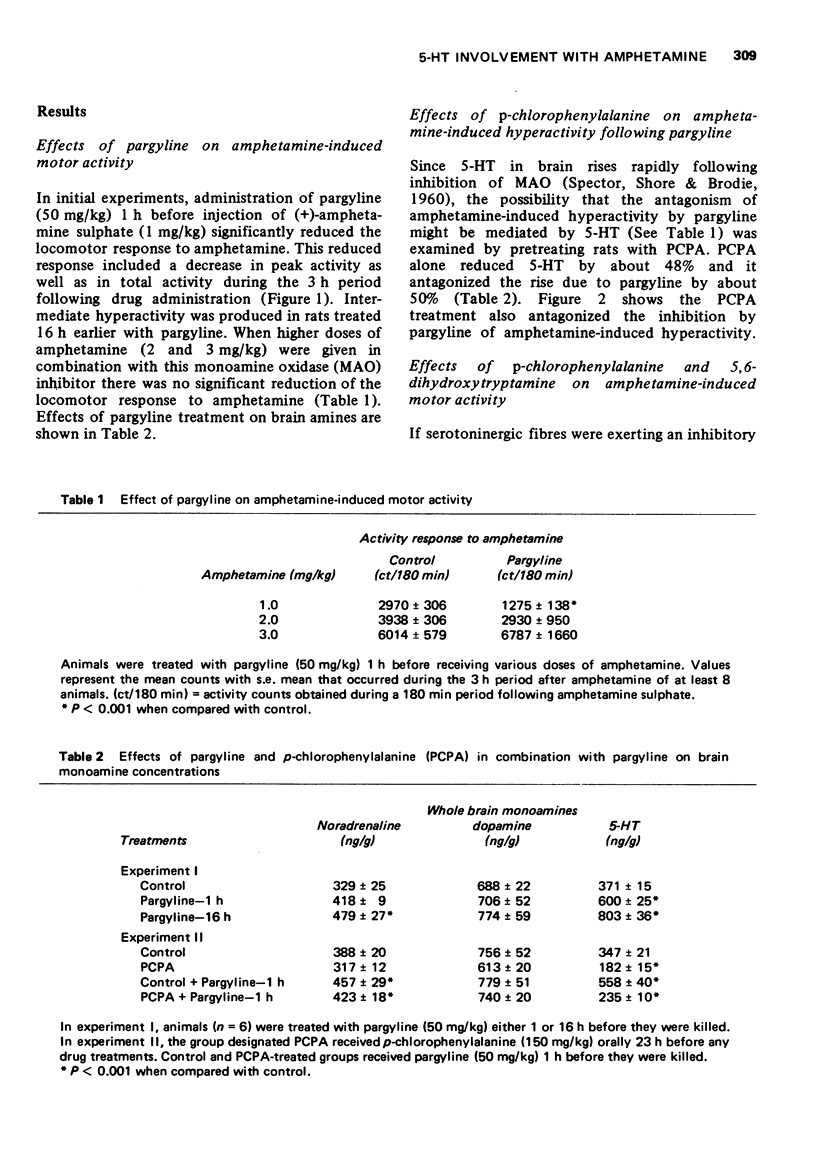

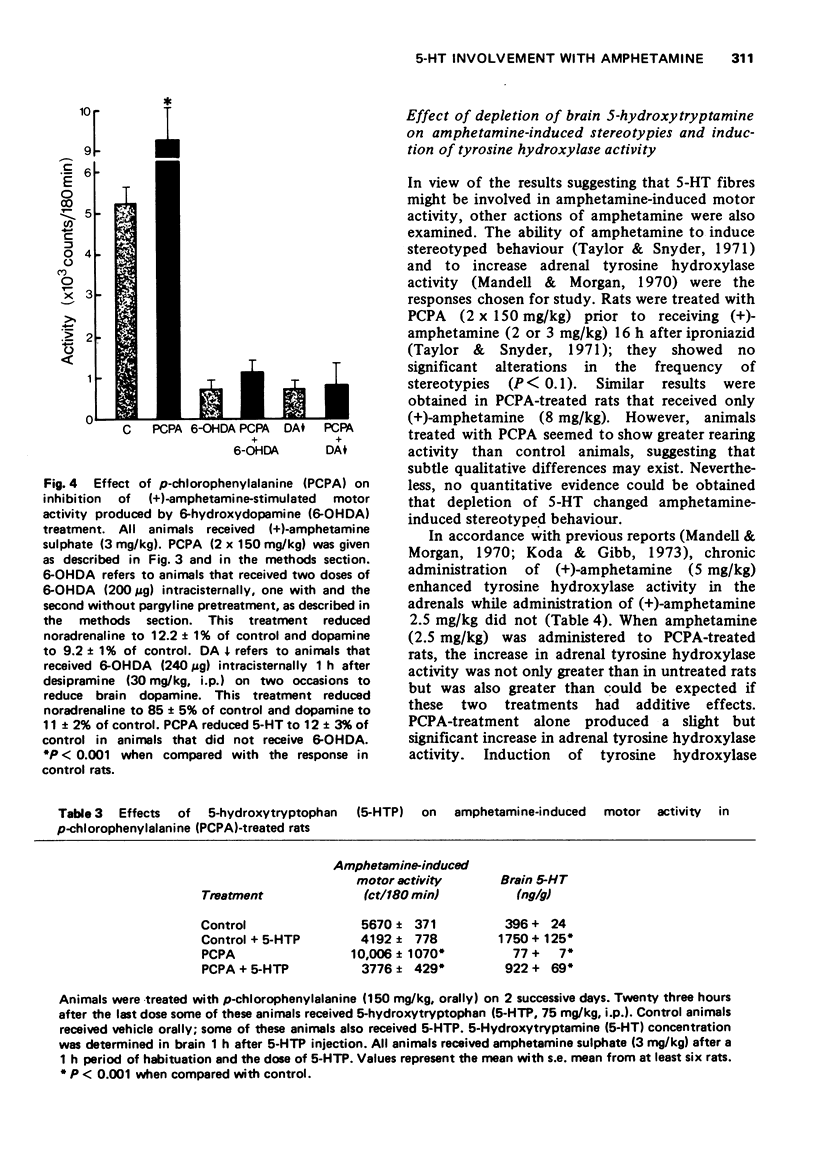
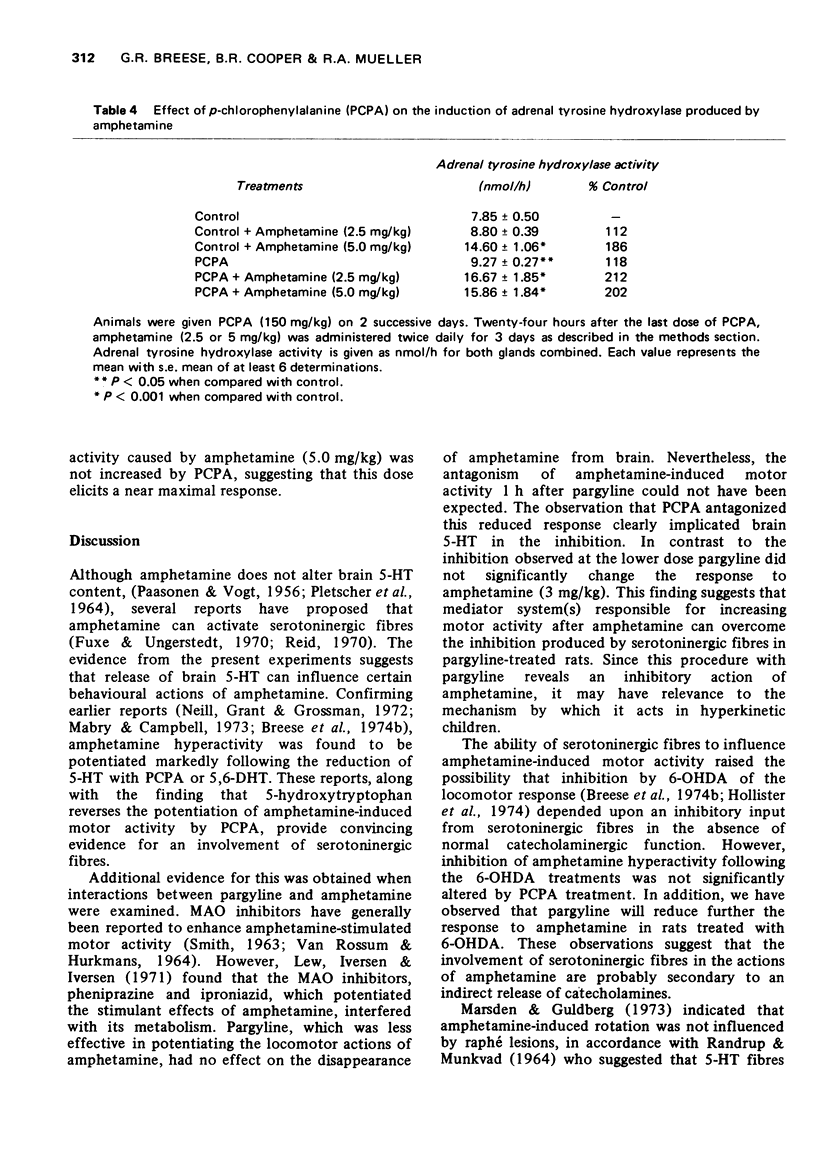
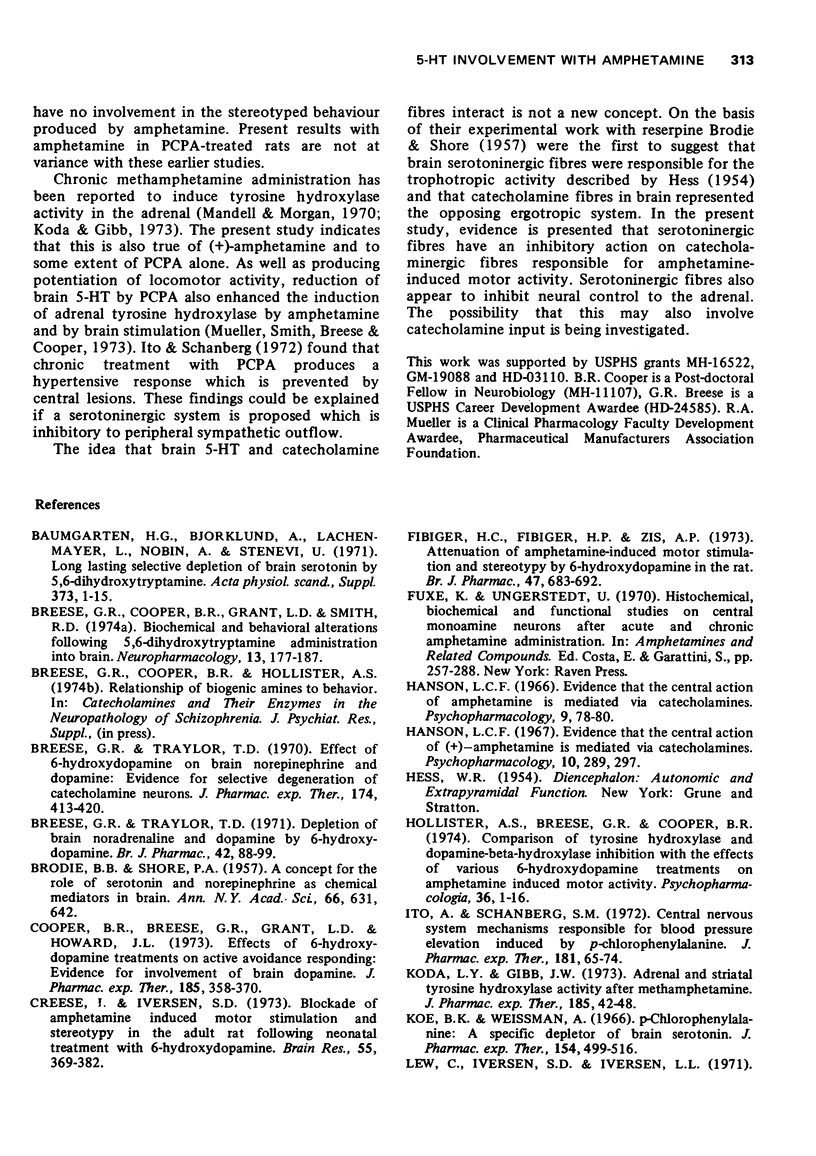
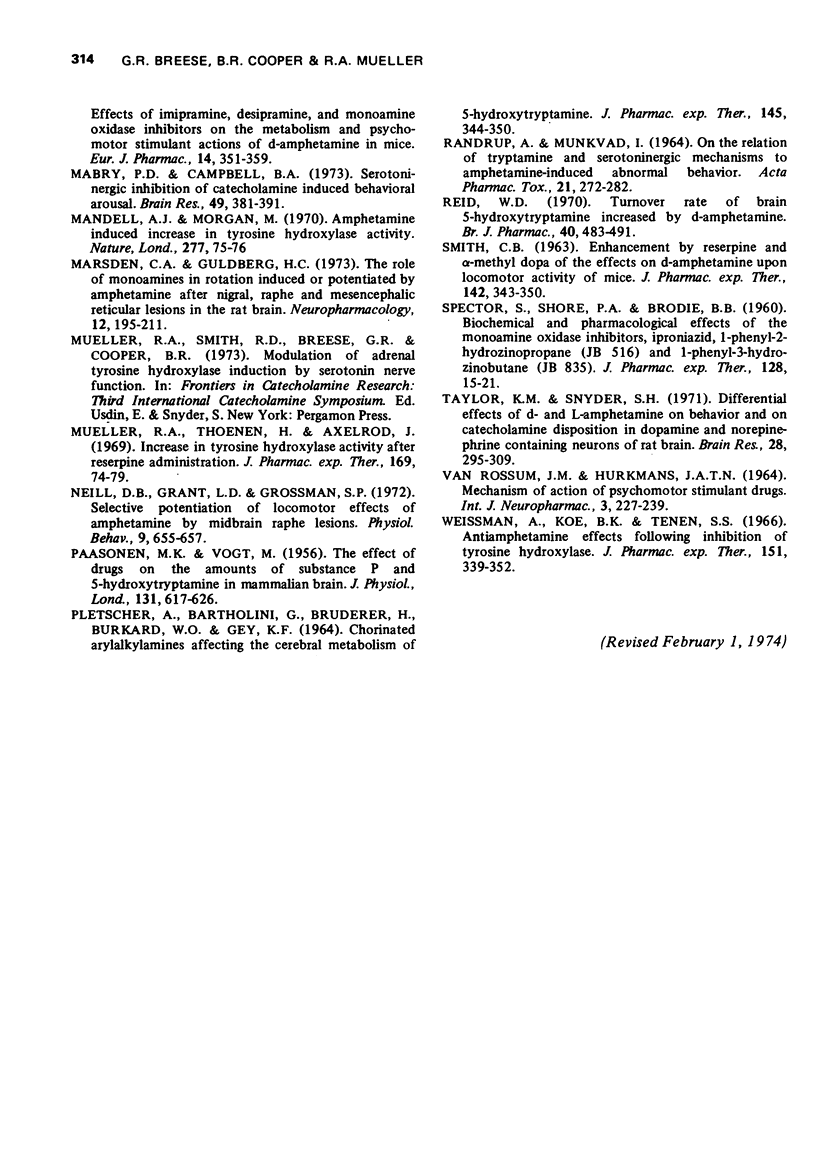
Selected References
These references are in PubMed. This may not be the complete list of references from this article.
- BRODIE B. B., SHORE P. A. A concept for a role of serotonin and norepinephrine as chemical mediators in the brain. Ann N Y Acad Sci. 1957 Mar 14;66(3):631–642. doi: 10.1111/j.1749-6632.1957.tb40753.x. [DOI] [PubMed] [Google Scholar]
- Breese G. R., Traylor T. D. Depletion of brain noradrenaline and dopamine by 6-hydroxydopamine. Br J Pharmacol. 1971 May;42(1):88–99. doi: 10.1111/j.1476-5381.1971.tb07089.x. [DOI] [PMC free article] [PubMed] [Google Scholar]
- Breese G. R., Traylor T. D. Effect of 6-hydroxydopamine on brain norepinephrine and dopamine evidence for selective degeneration of catecholamine neurons. J Pharmacol Exp Ther. 1970 Sep;174(3):413–420. [PMC free article] [PubMed] [Google Scholar]
- Cooper B. R., Breese G. R., Grant L. D., Howard J. L. Effects of 6-hydroxydopamine treatments on active avoidance responding: evidence for involvement of brain dopamine. J Pharmacol Exp Ther. 1973 May;185(2):358–370. [PubMed] [Google Scholar]
- Creese I., Iversen S. D. Blockage of amphetamine induced motor stimulation and stereotypy in the adult rat following neonatal treatment with 6-hydroxydopamine. Brain Res. 1973 Jun 15;55(2):369–382. doi: 10.1016/0006-8993(73)90302-8. [DOI] [PubMed] [Google Scholar]
- Fibiger H. C., Fibiger H. P., Zis A. P. Attenuation of amphetamine-induced motor stimulation and stereotypy by 6-hydroxydopamine in the rat. Br J Pharmacol. 1973 Apr;47(4):683–692. doi: 10.1111/j.1476-5381.1973.tb08194.x. [DOI] [PMC free article] [PubMed] [Google Scholar]
- Hanson L. C. Evidence that the CCENTRAL ACTION OF (+)-amphetamine is mediated via catecholamines. Psychopharmacologia. 1967;10(4):289–297. doi: 10.1007/BF00403897. [DOI] [PubMed] [Google Scholar]
- Hanson L. C. Evidence that the central action of amphetamine is mediated via catecholamines. Psychopharmacologia. 1966;9(1):78–80. doi: 10.1007/BF00427706. [DOI] [PubMed] [Google Scholar]
- Hollister A. S., Breese G. R., Cooper B. R. Comparison of tyrosine hydroxylase and dopamine-beta-hydroxylase inhibition with the effects of various 6-hydroxydopamine treatments on d-amphetamine induced motor activity. Psychopharmacologia. 1974 Mar 21;36(1):1–16. doi: 10.1007/BF00441377. [DOI] [PubMed] [Google Scholar]
- Ito A., Schanberg S. M. Central nervous system mechanisms responsible for blood pressure elevation induced by p-chlorophenylalanine. J Pharmacol Exp Ther. 1972 Apr;181(1):65–74. [PubMed] [Google Scholar]
- Koda L. Y., Gibb J. W. Adrenal and striatal tyrosine hydroxylase activity after methamphetamine. J Pharmacol Exp Ther. 1973 Apr;185(1):42–48. [PubMed] [Google Scholar]
- Koe B. K., Weissman A. p-Chlorophenylalanine: a specific depletor of brain serotonin. J Pharmacol Exp Ther. 1966 Dec;154(3):499–516. [PubMed] [Google Scholar]
- Lew C., Iversen S. D., Iversen L. L. Effects of imipramine, desipramine and monoamine oxidase inhibitors on the metabolism and psychomotor stimulant actions of d-amphetamine in mice. Eur J Pharmacol. 1971 May;14(4):351–359. doi: 10.1016/0014-2999(71)90189-0. [DOI] [PubMed] [Google Scholar]
- Mabry P. D., Campbell B. A. Serotonergic inhibition of catecholamine-induced behavioral arousal. Brain Res. 1973 Jan 30;49(2):381–391. doi: 10.1016/0006-8993(73)90429-0. [DOI] [PubMed] [Google Scholar]
- Mandell A. J., Morgan M. Amphetamine induced increase in tyrosine hydroxylase activity. Nature. 1970 Jul 4;227(5253):75–76. doi: 10.1038/227075a0. [DOI] [PubMed] [Google Scholar]
- Marsden C. A., Guldberg H. C. The role of monoamines in rotation induced or potentiated by amphetamine after nigral, raphe and mesencephalic reticular lesions in the rat brain. Neuropharmacology. 1973 Mar;12(3):195–211. doi: 10.1016/0028-3908(73)90104-4. [DOI] [PubMed] [Google Scholar]
- Mueller R. A., Thoenen H., Axelrod J. Increase in tyrosine hydroxylase activity after reserpine administration. J Pharmacol Exp Ther. 1969 Sep;169(1):74–79. [PubMed] [Google Scholar]
- Neill D. B., Grant L. D., Grossman S. P. Selective potentiation of locomotor effects of amphetamine by midbrain raphé lesions. Physiol Behav. 1972 Oct;9(4):655–657. doi: 10.1016/0031-9384(72)90026-1. [DOI] [PubMed] [Google Scholar]
- PAASONEN M. K., VOGT M. The effect of drugs on the amounts of substance P and 5-hydroxytryptamine in mammalian brain. J Physiol. 1956 Mar 28;131(3):617–626. doi: 10.1113/jphysiol.1956.sp005486. [DOI] [PMC free article] [PubMed] [Google Scholar]
- PLETSCHER A., BARTHOLINI G., BRUDERER H., BURKARD W. P., GEY K. F. CHLORINATED ARYLALKYLAMINES AFFECTING THE CEREBRAL METABOLISM OF 5-HYDROXYTRYPTAMINE. J Pharmacol Exp Ther. 1964 Sep;145:344–350. [PubMed] [Google Scholar]
- RANDRUP A., MUNKVAD I. ON THE RELATION OF TRYPTAMINIC AND SEROTONERGIC MECHANISMS TO AMPHETAMINE INDUCED ABNORMAL BEHAVIOUR. Acta Pharmacol Toxicol (Copenh) 1964;21:272–282. doi: 10.1111/j.1600-0773.1964.tb01791.x. [DOI] [PubMed] [Google Scholar]
- Reid W. D. Turnover rate of brain 5-hydroxytryptamine increased by D-amphetamine. Br J Pharmacol. 1970 Nov;40(3):483–491. doi: 10.1111/j.1476-5381.1970.tb10629.x. [DOI] [PMC free article] [PubMed] [Google Scholar]
- SPECTOR S., SHORE P. A., BRODIE B. B. Biochemical and pharmacological effects of the monoamine oxidase inhibitors, iproniazid, 1-phenyl-2-hydrazinopropane (JB 516) and 1-phenyl-3-hydrazinobutane (JB 835). J Pharmacol Exp Ther. 1960 Jan;128:15–21. [PubMed] [Google Scholar]
- Taylor K. M., Snyder S. H. Differential effects of D- and L-amphetamine on behavior and on catecholamine disposition in dopamine and norepinephrine containing neurons of rat brain. Brain Res. 1971 May 7;28(2):295–309. doi: 10.1016/0006-8993(71)90661-5. [DOI] [PubMed] [Google Scholar]
- VAN ROSSUMJ, HURKMANS A. T. MECHANISM OF ACTION OF PSYCHOMOTOR STIMULANT DRUGS. SIGNIFICANCE OF DOPAMINE IN LOCOMOTOR STIMULANT ACTION. Int J Neuropharmacol. 1964 May;3:227–239. doi: 10.1016/0028-3908(64)90012-7. [DOI] [PubMed] [Google Scholar]
- Weissman A., Koe B. K., Tenen S. S. Antiamphetamine effects following inhibition of tyrosine hydroxylase. J Pharmacol Exp Ther. 1966 Mar;151(3):339–352. [PubMed] [Google Scholar]


